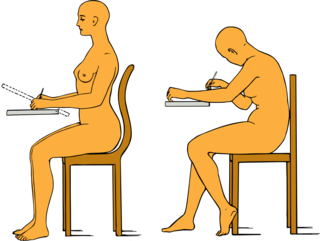Health
Heads Up! Good Posture Helps Both Your Mind and Your Body
Slouching can be hazardous to your mental health as well as to physical health.
Updated May 8, 2024 Reviewed by Hara Estroff Marano
Key points
- Poor posture can increase your risk of falling, pain, and fatigue.
- Besides the expected physical benefits, good posture has unexpected mental health benefits.
- Developing good posture is a process, not an event.

“Pretty good posture?”
A few years ago, I went to see a physical therapist for back issues. He analyzed the problem and then said, “On the plus side, you’re in good physical shape, and you have pretty good posture.”
“What do you mean ‘pretty good?’” I retorted. I prided myself on my excellent (or so I thought) posture. I had worked for decades to follow every posture instruction from my old aerobics videos. What could be wrong?
The PT set me straight. “Well, you have head-forward posture,” he told me. “That’s not good, and unless you do something about it, it will only get worse as you age.”
I knew he was right about my "bookworm posture." I began practicing posture exercises that day—and I still practice. I've persisted because I feel uplifted, both physically and mentally, when I sit or stand with an upright posture. And I’m not the only one, according to the research below.
Here’s what I’ve learned about the pitfalls of poor posture and the wonderful, and often unexpected, mental benefits of good posture. And I’ll offer tips about training yourself to have better posture.
The Pitfalls of Poor Posture
The word “pitfall” is unfortunately the perfect word for what happens when you neglect to stand up straight. Poor posture raises your risk of falling. Why? Dr. Beth Templin, a physical therapist specializing in the challenges of aging, explains that hunched over posture will throw off your balance: “Your body is no longer in good alignment, and that begins to affect your center of gravity.” And falling, especially as you age, raises your risk of injury and even death.
Slouched posture can also cause fatigue. The Mayo Clinic reports that “Poor postural habits may restrict your rib cage and compress your diaphragm. This can reduce lung capacity, leading to shallow or labored breathing, fatigue, and lack of energy, which can affect your overall productivity.” Templin notes that hunching over can also stress your heart for the same reason.
Poor sitting posture, such as slouching in your chair, can lead to neck, shoulder, back pain, or eyestrain. Some people find that poor posture can even trigger headaches.
And speaking of headache and neck pain, gazing down at your phone for hours on end increases the stress on your neck. The result? That bent-over shape that psychologist Amy Cuddy dubs “iPosture.”
Good Posture Is Good for Mental Health
And now the good news: Recent research tells us that correct posture generates an unexpected bonus of mental health and brain benefits, along with less physical pain, fatigue, and the other ills mentioned above. Here are a few of the surprising positives of good posture:
- Good posture helps reduce stress and can increase positive mood and self-esteem. In a small study of 74 participants, researchers concluded that, “Adopting an upright seated posture in the face of stress can maintain self-esteem, reduce negative mood, and increase positive mood compared to a slumped posture.” The researchers further note that “Sitting upright may be a simple behavioral strategy to help build resilience to stress.”
- Good posture increases confidence. While there is some debate about “power poses” and whether they really work, several small studies indicate that good posture does increase confidence. In one study, students who maintained an upright posture had more confidence in their own thoughts as they speculated about future job performance.
- Good posture activates your assertiveness. When you stand tall, your posture promotes respect from others as well as self-respect, regardless of your actual position in an organizational hierarchy, according to research. It may also increase your chances of success in a job search.
- Good posture helps you perform better under pressure. In a study of 125 college students asked to do simple math problems, those who sat upright reported they found it easier to do the math. The authors of the study speculate that using an empowered position can help your focus on a variety of performance situations, not just math tests.
It’s easy to test out some of these propositions for yourself. Practice good posture in a variety of situations; see for yourself whether you feel more confident, assertive, or productive. Not that it’s always easy. Sometimes standing up straight makes a shy person feel like they are taking up too much space. Self-beliefs about worth and cultural stereotypes come into play if, for example, a woman makes herself large instead of making herself small. Thinking differently can help you overcome such uncomfortable feelings. And, remember, strong posture itself might help you think differently.
How to Develop the Good-Posture Habit
Poor posture is not always a bad habit. Typical physical problems that affect posture include bone loss (osteoporosis or osteopenia), spinal disc shrinkage, and loss of muscle mass. Fortunately, some of these problems can be solved with medication, exercise, physical therapy, and practice.
A session of PT could help you know what good posture feels like. (This video by TEDEd offers excellent tips and visuals.) Consider adopting these tips from the Harvard Health Letter:
- Keep your chin parallel to the floor.
- Keep your shoulders back and down.
- Activate your abdominal muscles to pull up from your waist. Suddenly you’ve grown an inch in height and lost an inch around your waist.
- Keep hips and knees even, with knees pointing straight ahead.
- Distribute body weight evenly on both feet.
- Aim for a neutral spine (no arching).
To develop a good-posture habit, you must be willing to put in a small amount of daily conscious effort. Here are some tactics to try:
1. Notice when you have that slouchy feeling. That's a cue to correct yourself and stand or sit up straighter (not to berate yourself).
2. Use your abdominal muscles (abs) to pull yourself more upright. The more you practice good posture, the stronger your abs will become.
3. Do exercises that develop muscle strength. Strong leg muscles make it possible to stand correctly; strong core muscles (abs, back, side, pelvis, butt) prevent slumping.
4. When sitting, get up and move around for five minutes or so every 30-60 minutes. Your whole body will benefit.
5. Create a posture-friendly office. Invest in a good desk chair that supports your back and allows you to sit comfortably upright. Arrange your computer monitor so that you don’t have to bend your neck down to view the screen. Raise your phone to eye level so you’re not always looking down at it with bent neck.
Few people can maintain correct posture all day long, so don’t feel bad if you find yourself slouching sometimes. Good posture involves a constant process of adjusting yourself. My motto: Good posture is a process, not an event.
Straight Talk Summary
It turns out there are many virtues of practicing and creating the habit of good posture as you age. As I say in my book Silver Sparks, good posture is an easy way to reverse some of the effects of aging without spending a cent or risking your health: “The decision to adopt better posture when standing, sitting, or moving may not change your DNA, but good posture is an easy way to broadcast youth and vitality, help you breathe better, and protect your spine, shoulders, and neck.”
So, if you are looking for a worthwhile New Year’s resolution, consider this one: Straighten up!
© Meg Selig, 2022.
References
Selig, M. (2020) Silver Sparks: Thoughts on Growing Older, Wiser, and Happier. Sierra Vista, AZ: Jetlaunch.




